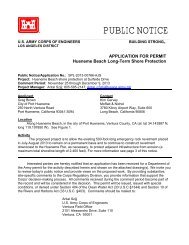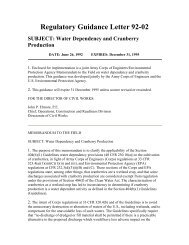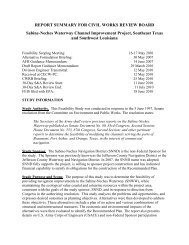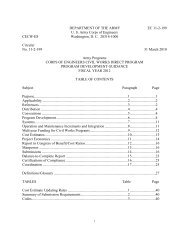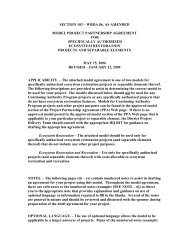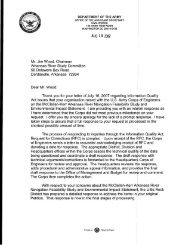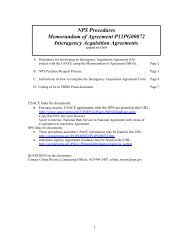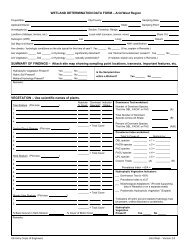Hawaii and the Pacific Islands - U.S. Army Corps of Engineers
Hawaii and the Pacific Islands - U.S. Army Corps of Engineers
Hawaii and the Pacific Islands - U.S. Army Corps of Engineers
Create successful ePaper yourself
Turn your PDF publications into a flip-book with our unique Google optimized e-Paper software.
ERDC/EL TR-12-5 6ture fluctuations (USDA Natural Resources Conservation Service 2006).However, <strong>the</strong>re is considerable spatial variability in both temperature <strong>and</strong>rainfall, especially on <strong>the</strong> higher isl<strong>and</strong>s that have greater topographicdiversity <strong>and</strong> relief.The variety <strong>of</strong> topographic, soil, <strong>and</strong> climatic conditions across <strong>the</strong> region,along with geographic isolation, has encouraged <strong>the</strong> development <strong>of</strong> adiverse <strong>Pacific</strong> flora with many species endemic to particular isl<strong>and</strong>s <strong>and</strong>isl<strong>and</strong> groups. The natural climax communities in <strong>the</strong> region range fromhigh-elevation alpine <strong>and</strong> subalpine communities to wet, mesic, <strong>and</strong> dryhardwood forests, shrubl<strong>and</strong>s, grassl<strong>and</strong>s, coastal str<strong>and</strong>, <strong>and</strong> coral atollplant communities. Waves <strong>of</strong> human colonizers added large numbers <strong>of</strong>introduced <strong>and</strong> invasive plants to <strong>the</strong> flora, particularly in Hawai‘i. EarlyPolynesian settlers carried with <strong>the</strong>m a number <strong>of</strong> important food plants,including taro (Colocasia esculenta), sweet potatoes (Ipomoea batatas),breadfruit (Artocarpus altilis), bananas (Musa acuminata), <strong>and</strong> yams(Dioscorea spp.) (Juvik <strong>and</strong> Juvik 1998). However, prior to <strong>the</strong> arrival <strong>of</strong>Europeans, most <strong>of</strong> <strong>the</strong> isl<strong>and</strong>s remained dominated largely by a complex<strong>and</strong> unique native flora. Settlement by Europeans (<strong>and</strong>, later, by Americans,Japanese, <strong>and</strong> o<strong>the</strong>rs) led to large-scale agricultural development,primarily for sugarcane (Saccharum <strong>of</strong>ficinarum) production in <strong>the</strong><strong>Hawaii</strong>an Isl<strong>and</strong>s <strong>and</strong> coconut oil <strong>and</strong> copra (Cocos nucifera) in AmericanSamoa <strong>and</strong> <strong>the</strong> Marianas. Following World War II, l<strong>and</strong>s in sugarcaneproduction were converted to pasturel<strong>and</strong>, secondary agro-forestry, <strong>and</strong>subsistence agriculture (Nakamura 1984; Young 1989; USDA NaturalResources Conservation Service 2006). Large-scale agriculture (e.g., forpineapple [Ananas comosus] <strong>and</strong> c<strong>of</strong>fee [C<strong>of</strong>fea spp.]) remains prevalentin some areas, along with small commercial enterprises that grow food forlocal consumption. Many areas have become urbanized <strong>and</strong> industrializedwith large areas utilized for tourism <strong>and</strong> military purposes.The <strong>Hawaii</strong>an Isl<strong>and</strong>sIn <strong>the</strong> <strong>Hawaii</strong>an Isl<strong>and</strong>s, <strong>the</strong> average daily high temperature is about 84 °F(29 °C) <strong>and</strong> <strong>the</strong> average daily low temperature is 67 °F (19 °C) at sea level.However, temperatures at high elevations regularly dip below freezingduring <strong>the</strong> winter (Juvik <strong>and</strong> Juvik 1998). Average annual rainfall is about70 in. (1,780 mm), but varies greatly by location in relation to nor<strong>the</strong>asterlytrade winds <strong>and</strong> topography. Annual rainfall ranges from about10 to 60 in. (254 to 1,524 mm) on leeward slopes, <strong>and</strong> from 60 to morethan 400 in. (1,524 to more than 10,160 mm) on windward slopes. The



